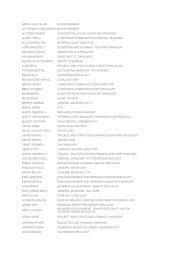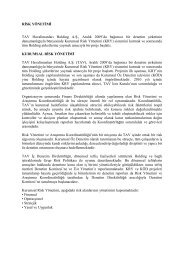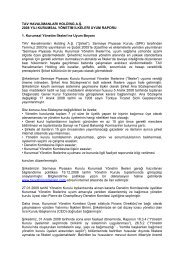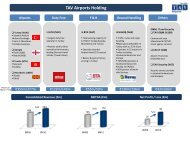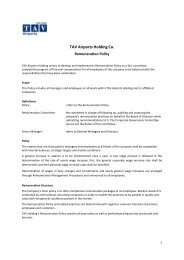TAV IT
TAV IT
TAV IT
Create successful ePaper yourself
Turn your PDF publications into a flip-book with our unique Google optimized e-Paper software.
140<br />
<strong>TAV</strong> Airports Holding Annual Report 2008<br />
<strong>TAV</strong> AIRPORTS HOLDING AND <strong>IT</strong>S SUBSIDIARIES<br />
NOTES TO THE CONSOLIDATED FINANCIAL STATEMENTS<br />
AS AT AND FOR THE YEAR ENDED 31 DECEMBER 2008<br />
(Amounts expressed in Euro unless otherwise stated)<br />
i) Impairment<br />
i) Financial assets:<br />
A financial asset is assessed at each reporting date to determine whether there is any objective evidence that it is impaired. A<br />
financial asset is considered to be impaired if objective evidence indicates that one or more events have had a negative effect on the<br />
estimated future cash flows of that asset.<br />
An impairment loss in respect of a financial asset measured at amortised cost is calculated as the difference between its carrying<br />
amount, and the present value of the estimated future cash flows discounted at the original effective interest rate. An impairment<br />
loss in respect of an available-for-sale financial asset is calculated by reference to its fair value.<br />
Individually significant financial assets are tested for impairment on an individual basis. The remaining financial assets are assessed<br />
collectively in groups that share similar credit risk characteristics.<br />
All impairment losses are recognised in profit or loss. Any cumulative loss in respect of an available-for-sale financial asset<br />
recognised previously in equity is transferred to profit or loss.<br />
An impairment loss is reversed if the reversal can be related objectively to an event occurring after the impairment loss was<br />
recognised. For financial assets measured at amortised cost and available-for-sale financial assets that are debt securities, the<br />
reversal is recognised in profit or loss. For available-for-sale financial assets that are equity securities, the reversal is recognised<br />
directly in equity.<br />
ii) Non-financial assets:<br />
The carrying amounts of the Group’s non-financial assets, other than inventories and deferred tax assets, are reviewed at<br />
each reporting date to determine whether there is any indication of impairment. If any such indication exists, then the asset’s<br />
recoverable amount is estimated. For goodwill and intangible assets that have indefinite lives or that one not yet available for use,<br />
the recoverable amount is estimated each year at the same time.<br />
The recoverable amount of an asset or cash-generating unit is the greater of its value in use and its fair value less costs to sell. In<br />
assessing value in use, the estimated future cash flows are discounted to their present value using a pre-tax discount rate that<br />
reflects current market assessments of the time value of money and the risks specific to the asset. For the purpose of impairment<br />
testing, assets are grouped together into the smallest group of assets that generates cash inflows from continuing use that are<br />
largely independent of the cash inflows of other assets or groups of assets (the “cash-generating unit”). The goodwill acquired in<br />
a business combination, for the purpose of impairment testing, is allocated to cash-generating units that are expected to benefit<br />
from the synergies of the combination.<br />
An impairment loss is recognised if the carrying amount of an asset or its cash-generating unit exceeds its estimated recoverable<br />
amount. Impairment losses are recognised in profit or loss. Impairment losses recognised in respect of cash-generating units are<br />
allocated first to reduce the carrying amount of any goodwill allocated to the units and then to reduce the carrying amount of the<br />
other assets in the unit (group of units) on a pro rata basis.<br />
An impairment loss in respect of goodwill is not reversed. In respect of other assets, impairment losses recognised in prior periods<br />
are assessed at each reporting date for any indications that the loss has decreased or no longer exists. An impairment loss is<br />
reversed if there has been a change in the estimates used to determine the recoverable amount. An impairment loss is reversed<br />
only to the extent that the asset’s carrying amount does not exceed the carrying amount that would have been determined, net of<br />
depreciation or amortisation, if no impairment loss had been recognised.






